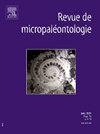理化参数和潜在有毒元素污染对底栖有孔虫和介形虫的影响——以埃及Burullus泻湖为例
IF 1
Q4 PALEONTOLOGY
引用次数: 0
摘要
Burullus泻湖位于埃及尼罗河三角洲北部,由于不断排放未经处理的农业径流和其南部地区水产养殖的影响,它面临着巨大的环境压力,这两者都导致水质下降和水生生态系统退化。本研究旨在评价以底栖有孔虫和介形虫作为生物标志物监测布卢勒斯咸淡海岸泻湖生态健康状况的有效性。2014年,收集了14个沉积物样本,以评估沉积物中的潜在有毒元素(pte)污染,并评估泻湖的环境质量。计算了3个污染指数:污染系数(CF)、地质富集系数(Igeo)和富集系数(EF)。CF和Igeo的平均值顺序为:Cd >;>;Pb祝辞公司在倪祝辞锌比;铜在所有采样站。统计分析显示有机碳的空间分布与pte之间没有相关性。全盐底栖有孔虫和介形类为氨温虫(氨温虫,Cushman, 1926)和环斑马鱼,对高水平的有机碳和pte污染表现出耐受性。物种多样性低,生存个体稀缺,畸形标本的存在可能直接反映了布鲁卢斯泻湖环境生态质量的下降。这项研究强调了泻湖生态健康状况的恶化,并强调了底栖有孔虫和介形类组合作为监测尼罗河三角洲咸淡海岸生态系统污染的有效生物指标的效用。本文章由计算机程序翻译,如有差异,请以英文原文为准。
Effects of physicochemical parameters and potential toxic elements pollution on benthic foraminifera and ostracoda: A case study of Burullus Lagoon, Egypt
The Burullus Lagoon, located in the northern Nile Delta in Egypt, faces significant environmental stress due to the continuous discharge of untreated agricultural runoff and the effects of aquaculture in its southern region, both of which contribute to declining water quality and to the degradation of the aquatic ecosystem. This study aimed to evaluate the effectiveness of using benthic foraminifera and ostracods as biomarkers for monitoring the ecological health of the brackish coastal Burullus Lagoon. In 2014, fourteen sediment samples were collected to assess potential toxic elements (PTEs) pollution in the sediments and evaluate the lagoon's environmental quality. Three pollution indices were calculated: contamination factor (CF), geo-accumulation index (Igeo), and enrichment factor (EF). The mean values of CF and Igeo indicated the following order: Cd >> Pb > Co > Ni > Zn > Cu across all sampling stations. Statistical analyses revealed no correlation between the spatial distributions of organic carbon and PTEs. The holoeuryhaline benthic foraminiferal and ostracod species Ammonia tepida (Cushman, 1926) and Cyprideis torosa dominated the benthic populations, showing tolerance to high levels of organic carbon and PTEs pollution. Low species diversity, a scarcity of living individuals, and the presence of deformed specimens may directly reflect the decline in the ecological quality of the Burullus Lagoon environment. This study highlights the deteriorating ecological health of the lagoon and underlines the utility of combined benthic foraminifera and ostracod assemblages as effective bioindicators for monitoring pollution in the brackish coastal ecosystems of the Nile Delta.
求助全文
通过发布文献求助,成功后即可免费获取论文全文。
去求助
来源期刊

REVUE DE MICROPALEONTOLOGIE
PALEONTOLOGY-
CiteScore
2.50
自引率
0.00%
发文量
17
期刊介绍:
La Revue de micropaléontologie publie 4 fois par an des articles de intérêt international, consacrés à tous les aspects de la micropaléontologie. Les textes, en anglais ou en français, sont des articles originaux, des résultats de recherche, des synthèses et mises au point, des comptes rendus de réunions scientifiques et des analyses de ouvrages. La revue se veut résolument ouverte à tous les aspects de la micropaléontologie en accueillant des travaux traitant de la systématique des microfossiles (et de leurs équivalents actuels), des bactéries aux microrestes de vertébrés, et de toutes leurs applications en sciences biologiques et géologiques.
 求助内容:
求助内容: 应助结果提醒方式:
应助结果提醒方式:


